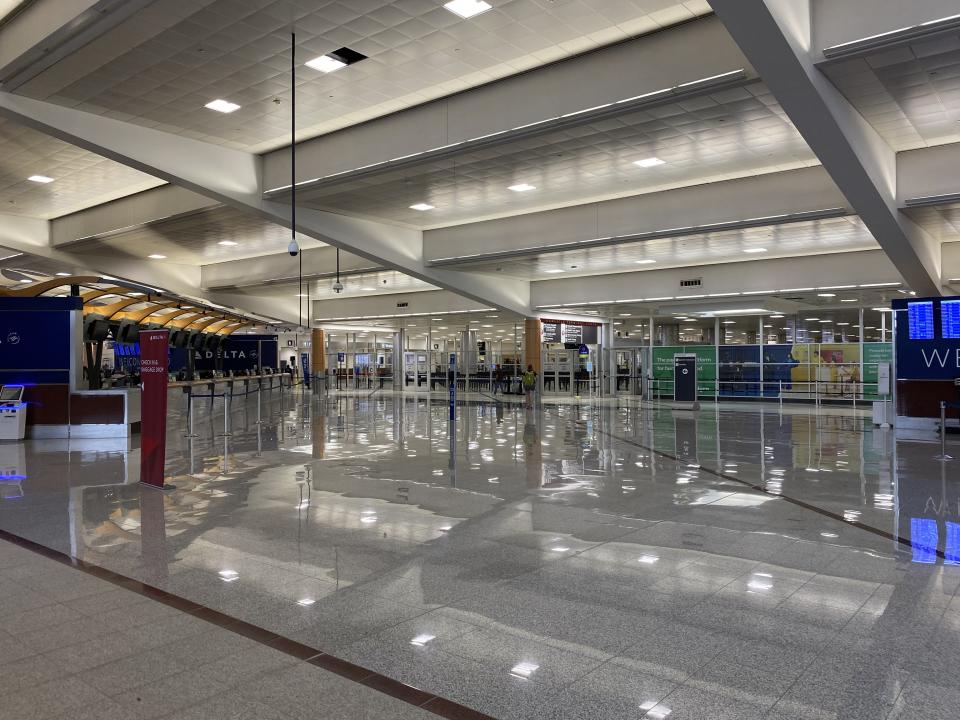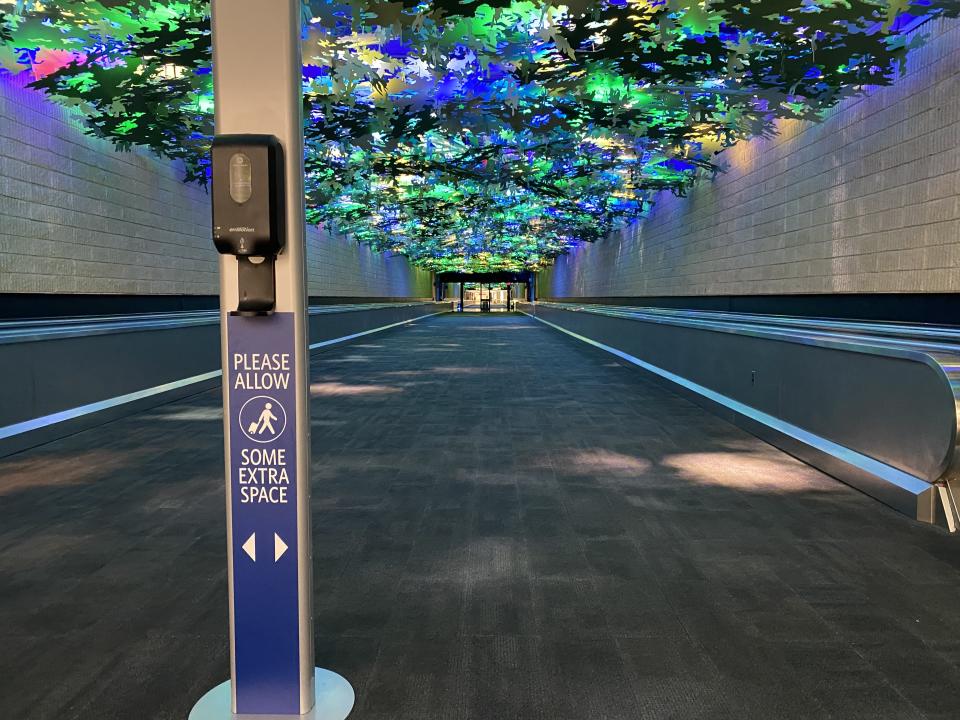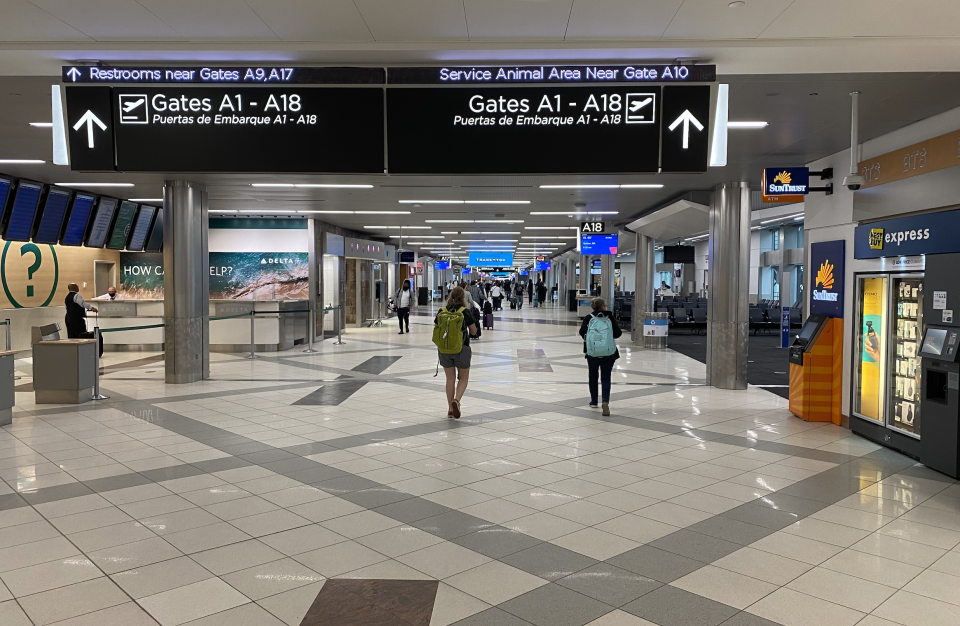Flying in the age of coronavirus: Air travel is changing fast

ATLANTA — The music is what gets you.
It’s a weekday morning in the world’s busiest airport, and some gentle, anonymous jazz music is playing overhead. On a normal business day, it’d be background noise, drowned out amid the usual din of rolling suitcases and cellphone conversations. But today, as the tasteful flute and silky bass echoes around the empty terminal, it’s disturbing, even a bit sinister, an exercise in post-apocalyptic scene-setting.
If you’ve traveled anywhere east of the Mississippi, you’ve probably flown through Atlanta’s Hartsfield-Jackson International Airport at least once in your life. You’ve sprinted between its hundreds of gates trying to make flights; you’ve tried to navigate its combination of escalators, trams, moving sidewalks. But I guarantee you’ve never seen it like this: at a fraction of capacity, with a distinct dystopian vibe.
Before All This, air travel was an exercise in managed frustration; you forced your way through airports alongside hundreds of fellow travelers, exactly none of whom moved at the pace you wanted. Now? Now it’s barely contained paranoia and suspicion. Which one of these people is an asymptomatic carrier? Why isn’t that guy wearing a mask? Wait, was that a COUGH? Even if you take a rational, data-driven approach to the pandemic, the side-eyes are everywhere.
One particularly cruel reminder of The Before Times: a table in a souvenir shop selling merchandise from the 2020 Final Four. Slated for Atlanta just last month — wait, really? — its cancellation brought home to sports fans just how serious the pandemic had become. (The shirts are 50 percent off, which still seems overpriced. I bought one anyway.)
What better way to remember a classic Final Four than with a commemorative t-shirt? pic.twitter.com/pSryFKMa1Z
— Jay Busbee (@jaybusbee) May 19, 2020
Flying through Hartsfield-Jackson right now is a stark look at what the COVID-19 pandemic has done to America’s airline infrastructure … and a preview of what’s likely to come for the nation’s air travelers, whenever they get back in the air.
On the day I travel, the TSA records 190,477 passengers passing through security at checkpoints across the nation. That’s a substantial increase from the low point of the shutdown — 87,534 on April 14 — but it’s only a fraction of the number that passed through the nation’s checkpoints on the same day last year: 2.3 million.
Fifteen months ago, when the Super Bowl was in town, the TSA line at Hartsfield-Jackson stretched from the queues out through a food court and around baggage claim. The wait was measured in hours. Now? Now, like the highway leading to the airport and the parking at it, you don’t have to break stride getting through security.
That won’t last. What will is the entirely new array of health-related restrictions and realigned flight operations. Already, some European airports are instituting temperature checks for passengers; you clock triple digits, you’re not flying. The Wall Street Journal reported last week that the TSA is looking at similar measures here. Also under consideration: health declarations, once there’s a vaccine, or “immunity passports” verifying that you’ve recovered from COVID-19. And you thought the TSA was invading your personal space before.
However, there is as yet no coronavirus screening protocol in place at any American airport. Proposals have included a secondary screening perimeter that could include temperature checks, questionnaires and, eventually, rapid COVID-19 tests. The White House is reportedly preparing to roll out those temperature checks at a dozen U.S. airports in the coming days.

Until then, we have signs and sanitizer. Newly placed throughout Atlanta’s airport are stands with hand sanitizer dispenser and signs politely suggesting “Please allow some extra space.” At the moment, there aren’t enough people circulating in the airport for social distancing to be a problem.
Worth noting: I observed well over 75 percent of travelers, and 100 percent of airport staff, wearing masks. Delta, among other carriers, is requiring masks for everyone on every flight. That’s going to be tested by someone eventually, but while I was passing through the terminal, I didn’t spot any let-me-speak-to-your-manager throwdowns. (I was definitely looking. A cellphone video of an airport battle over personal freedoms is guaranteed to — pardon the expression — go viral.)
It will take airlines months or years to recover from the nosedive in demand. Already, carriers have removed routes and even halted flights entirely to certain airports. In the future, you can expect fewer direct flights between airports — which means you’ll be spending time in Atlanta, like it or not.
You know how we got here. Airlines maximized revenue by packing in more passengers per plane, jacking up change fees and charging for previously free amenities like seat selection and carry-on luggage. Those revenue streams are no longer available or even possible; most airlines have waived change fees, and many forces, including Congress, are pressuring airlines to leave some seats empty in order to maintain some version of social distancing.
Rep. Peter DeFazio (D-Ore.), chairman of the House Transportation and Infrastructure Committee, saw a recent photo of passengers crowded onto a jet and wrote to the airline industry’s association seeking change.
“Despite Centers for Disease Control recommendations regarding social distancing, the picture shows nearly every seat is filled. And although many passengers are wearing masks or other protective face coverings, they look worried,” DeFazio wrote. “I would respectfully urge [airline industry] members to ensure that their reservation systems leave at least one seat-width of spacing between passengers and to dynamically adjust fares as needed to account for the effect on load factors.”
The International Air Transport Association, per the WSJ, estimates that flights need to be 77 percent full, on average, for airlines to break even. Removing a third or half of available seats means ticket prices will need to increase by a commensurate amount. And if you factor in the likelihood that business travelers, a reliable source of revenue, won’t be turning out in force anymore as businesses look to cut costs, that round-trip ticket is going to cost even more.

As I wait in a half-empty gate for my plane to be cleaned, I see a fellow passenger skateboarding right down the center of Terminal A. Skateboarding.
He glides past airport workers hauling crates of snacks. In yet another new move, airlines hand you a plastic bag with bottled water, snacks and sanitizing wipes. Farewell, drink cart. (On the plus side, you don’t have to choose between cookies and Cheez-Its anymore.)
Our flight is less than half-full. We shuffle onto the plane, the unreality of it all hanging almost visible in the air. The overhead bins are almost completely empty — another bit of strangeness — and as we find our seats, one flight attendant has apparently taken it upon herself to singlehandedly raise our spirits. Part motivational speaker, part cheerleader, she claps her hands and addresses each one of us as we make our way onto the plane.
“Keep living your life!” she chants. “Got to keep living your life.”
She sounds happy, and she might be smiling. I can’t tell. She’s wearing a mask.
_____
Jay Busbee is a writer for Yahoo Sports. Follow him on Twitter at @jaybusbee or contact him with tips and story ideas at jay.busbee@yahoo.com.


